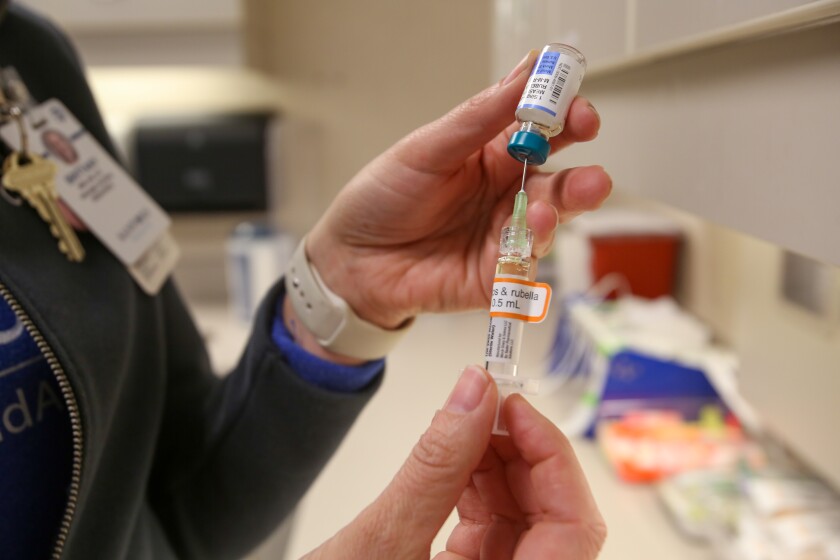FARGO — As fewer people in North Dakota vaccinate their children for measles, some counties, particularly in the west, may struggle with the contagious and fatal disease, health experts say.
On Friday, May 2, North Dakota reported its first case of measles since 2011. The infected child is from Williams County and was not vaccinated, according to the North Dakota Department of Health and Human Services.
Public health officials believe the child contracted the disease from an out-of-state visitor.
The state has since confirmed at least eight more cases. Seven are in individuals 19 years and younger, and all nine who were infected were unvaccinated, according to Health and Human Services.
Those infected have been isolated at home, the agency said. People who were in the Williston Walmart from 2 to 5 p.m. on April 29 may have been exposed, according to state officials.
The state also has ordered students who don’t have the measles, mumps and rubella (MMR) vaccination to be pulled from three Williston schools for 21 days, in accordance with state law.
It’s unclear how fast the disease will spread, said Molly Howell, immunization director at Health and Human Services.
“Measles is one of the most contagious viruses on Earth,” she said. “You kind of have to expect some spread when you have a measles case, especially when you have vaccination rates that are lower than what's recommended for measles.”
Public health officials recommend that 95% of the population be vaccinated to prevent widespread infection. North Dakota’s rate is less than 90%, according to state data.
ADVERTISEMENT
The state is doing everything it can to prevent further spread in Williams County, Howell said.
The disease is airborne and can linger in the air of a room for hours after a person leaves, said Dr. Paul Carson, a former North Dakota State University professor who taught infectious disease epidemiology. With vaccination rates in Williams just above 80%, the state can expect more cases, he said.
State health officials have been preparing for measles to arrive in North Dakota for quite some time, Carson said. Unless more people get on board with vaccinations, the likelihood of infections continuing is high, he said.
“Whether families and schools and so on are prepared, I think it is another story,” he said. “We are going to see that play out right in front of us as we speak.”
Dropping rates
The percentage of people getting vaccines to fight measles and other diseases — polio, chickenpox, diphtheria, tetanus and whooping cough, to name a few — have dropped across the state since the coronavirus pandemic, according to state data.
The U.S. Centers for Disease Control and Prevention recommends children get two shots of the MMR vaccine — first between the ages of 12 and 15 months, then again between 4 and 6 years old. One dose is 93% effective against measles, and two is 97%, the CDC said.
ADVERTISEMENT
The vaccine typically protects a person for life, the CDC said.
North Dakota had an MMR vaccination rate of almost 95% in the 2019-2020 school year, the peak rate in the 2010s and 2020s, Health and Human Services said. Minnesota also saw a declining trend, with rates going from almost 93% in the 2019-20 school year to just below 87% this school year, according to the Minnesota Department of Health.
Western North Dakota is particularly vulnerable, Carson said. Many counties west of Bismarck have rates less than 90%, according to state data.
Eight counties in North Dakota have rates that are less than 80%. McKenzie County, which is south of Williams, has a rate of 70%, and nearby Billings has 67%, according to Health and Human Services.
The lowest rate was in Sheridan County in central North Dakota with 57%, according to state data. Steele and Benson counties had the highest rate with 100%, the state said.
Cass County was above the state average with nearly 93%. Clay County (87.4%) in Minnesota was slightly above its state’s average, according to the Minnesota Health Department.
Minnesota has reported two cases. One was in March with no exposures, Minnesota Health Department spokesman Garry Bowman said.
ADVERTISEMENT
The second involved a child less than a year old, meaning they were too young for the MMR vaccine, he said. The child was diagnosed in another country and was not infectious when they came back to Minnesota, he said.
Bowman declined to provide more information about the case due to privacy laws.
Vaccination rates have fallen in recent years across the U.S., according to the CDC. Carson attributed the decline to the vaccine’s success.
The U.S. in 2000 declared measles eliminated. The last case in North Dakota before 2011 was 1987, Howell said.
She attributed that to traditionally high vaccination rates, up until the COVID-19 pandemic.
“This is not something that I want to become routine,” she said.
Carson said many of his colleagues have never seen a case of measles. On top of that, people have become more concerned about the potential side effects of the MMR vaccine, he said. The coronavirus pandemic also brought with it mistrust in medical authorities and public health, he said.
ADVERTISEMENT
“The vaccines have become victims of our own success,” Carson said. “These diseases have faded from our collective consciousness.”
'Not a benign disease'
The CDC said three in 100 vaccinated people can get measles, though symptoms are usually mild compared to unvaccinated people. Fully vaccinated people are less likely to spread the disease, the CDC said.
In comparison, nine out of 10 unvaccinated children contracted measles, Howell said. Measles is contagious after symptoms first appear and about four days after the rash appears, according to the CDC.
Carson noted that three of 1,000 unvaccinated children who get measles die.
“That’s healthy, well-nourished kids,” he said. “It’s much, much worse in developing countries where there’s problems with malnutrition.”
As of Friday, the U.S. reported 935 cases this year, with almost 70% reported in children. Almost all the cases happened in unvaccinated people, the CDC said.
Three people have died, and 13% were hospitalized, according to the CDC.
ADVERTISEMENT
The CDC said 20% to 25% cases result in hospitalizations, and 1 in 1,000 infections lead to encephalitis, resulting in a brain inflammation that can lead to seizures, deafness or intellectual disability.
Other complications can include pneumonia, hearing loss, and a rare but fatal progressive brain disorder that occurs seven to 10 years after infection, Carson said. New information revealed measles also can attack the immune system, he said, meaning other infections can kill children.
“This is not a benign disease,” he said. “This is something we absolutely want to avoid, and it is completely preventable.”
Sanford Health in Fargo is prepared to handle cases, said Dr. Avish Nagpal, an infectious disease physician with the local health care provider. It’s only a matter of time until it reaches the Fargo area, he said, adding that it is spreading in other states.
The only treatment available for measles is supportive, which includes rest, hydration and pain control, Nagpal said. No treatment exists to directly treat the virus, and doctors have to let the illness run its course, he said.
It’s never too late to get the MMR vaccine, Nagpal said. It is most effective before exposure and takes about 14 days to go into effect, he said.
“As long as they can get a vaccine … within 3 days after exposure, it will still work,” he said. “The earlier, the better.”
The MMR vaccine is the most effective way to fight measles and is safe, Carson said. The state is recommending children as young as 6 months old get the vaccine if they live in or travel to Williams County, Howell said. The second dose can be administered 28 days later, she said.
Howell advised people to weigh the risks associated with measles with the risk of vaccinations, which are low, she added.
“We’re just hoping that people just rethink their decision and have a conversation with a trusted health care provider about the measles vaccine and really get their information from a reliable source and not necessarily from social media or the internet,” Howell said.


















